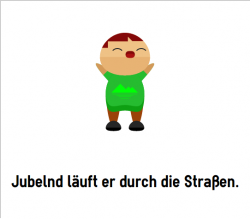German present participle (participle I)
Sign up for free to get all information about private lessons and our available group courses (A1, A2, B2, B2, C1, C2)
Sign up for freeSign up for free to get all information about private lessons and our available group courses (A1, A2, B2, B2, C1, C2)
Sign up for freeBuilding the German participle I is really simple. All you need to do is add an "-d" to the infinitive form of the verb.
| Infinitive | Participle |
|---|---|
| Laufen (to walk) | Laufend |
| Springen (to jump) | Springend |
| Fahren (to drive) | Fahrend |
![]() The only irregularity happens with the word "sein" (to be). In this case, another "-e" will be added: sein → seiend
The only irregularity happens with the word "sein" (to be). In this case, another "-e" will be added: sein → seiend
Take online language lessons with a professional teacher
You use the present participle instead of a subset for one of two actions, that takes places simultaneously. A second way to use the present participle is to use it as an attributive adjective.
| present participle | use of present participle |
|---|---|
Ein in der Tür stehender Mann. (A man standing in the door) | attributive adjective with declension. |
Singend geht er in die Dusche (He goes in the shower singing) | two actions happening at the same time (singen, gehen) |
Knurrend liegt der Hund hinter der Tür (Growling the dog lies behind the door) | two actions happening at the same time (liegen, knurren) |
Lachend verlassen die Kinder die Schule (The kids leave the school laughing) | two actions happening at the same time (lachen, verlassen) |
![]() Now, that you have learned about the past participle and the present participle form, move on to our free and online exercises in order to test your abilities.
Now, that you have learned about the past participle and the present participle form, move on to our free and online exercises in order to test your abilities.